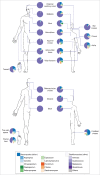Topographical and physiological differences of the skin mycobiome in health and disease
- PMID: 27754756
- PMCID: PMC5411233
- DOI: 10.1080/21505594.2016.1249093
Topographical and physiological differences of the skin mycobiome in health and disease
Abstract
Skin constantly encounters external elements, including microbes. Culture-based studies have identified fungi present on human skin and have linked some species with certain skin diseases. Moreover, modern medical treatments, especially immunosuppressants, have increased the population at risk for cutaneous and invasive fungal infections, emphasizing the need to understand skin fungal communities in health and disease. A major hurdle for studying fungal flora at a community level has been the heterogeneous culture conditions required by skin fungi. Recent advances in DNA sequencing technologies have dramatically expanded our knowledge of the skin microbiome through culture-free methods. This review discusses historical and recent research on skin fungal communities - the mycobiome - in health and disease, and challenges associated with sequencing-based mycobiome research.
Keywords: Malassezia; fungal community; mycobiome; skin.
Figures
Similar articles
-
The gut mycobiome of the Human Microbiome Project healthy cohort.Microbiome. 2017 Nov 25;5(1):153. doi: 10.1186/s40168-017-0373-4. Microbiome. 2017. PMID: 29178920 Free PMC article.
-
Temporal Stability of the Healthy Human Skin Microbiome Following Dead Sea Climatotherapy.Acta Derm Venereol. 2018 Feb 7;98(2):256-261. doi: 10.2340/00015555-2769. Acta Derm Venereol. 2018. PMID: 28815268
-
Amphibian skin fungal communities vary across host species and do not correlate with infection by a pathogenic fungus.Environ Microbiol. 2019 Aug;21(8):2905-2920. doi: 10.1111/1462-2920.14682. Epub 2019 Jun 18. Environ Microbiol. 2019. PMID: 31087743
-
Mining the oral mycobiome: Methods, components, and meaning.Virulence. 2017 Apr 3;8(3):313-323. doi: 10.1080/21505594.2016.1252015. Epub 2016 Oct 28. Virulence. 2017. PMID: 27791473 Free PMC article. Review.
-
The vaginal mycobiome: A contemporary perspective on fungi in women's health and diseases.Virulence. 2017 Apr 3;8(3):342-351. doi: 10.1080/21505594.2016.1237332. Epub 2016 Sep 22. Virulence. 2017. PMID: 27657355 Free PMC article. Review.
Cited by
-
Cross-Domain and Viral Interactions in the Microbiome.Microbiol Mol Biol Rev. 2019 Jan 9;83(1):e00044-18. doi: 10.1128/MMBR.00044-18. Print 2019 Mar. Microbiol Mol Biol Rev. 2019. PMID: 30626617 Free PMC article. Review.
-
The emerging importance and challenges of the human mycobiome.Virulence. 2017 Apr 3;8(3):310-312. doi: 10.1080/21505594.2017.1279780. Epub 2017 Jan 19. Virulence. 2017. PMID: 28102762 Free PMC article. No abstract available.
-
Therapeutic responses to Roseomonas mucosa in atopic dermatitis may involve lipid-mediated TNF-related epithelial repair.Sci Transl Med. 2020 Sep 9;12(560):eaaz8631. doi: 10.1126/scitranslmed.aaz8631. Sci Transl Med. 2020. PMID: 32908007 Free PMC article. Clinical Trial.
-
Sarcoptic mange changes bacterial and fungal microbiota of bare-nosed wombats (Vombatus ursinus).Parasit Vectors. 2022 Sep 13;15(1):323. doi: 10.1186/s13071-022-05452-y. Parasit Vectors. 2022. PMID: 36100860 Free PMC article.
-
Pityriasis Versicolor-A Narrative Review on the Diagnosis and Management.Life (Basel). 2023 Oct 22;13(10):2097. doi: 10.3390/life13102097. Life (Basel). 2023. PMID: 37895478 Free PMC article. Review.
References
-
- Human Microbiome Project C Structure, function and diversity of the healthy human microbiome. Nature 2012; 486:207-14; PMID:22699609; http://dx.doi.org/10.1038/nature11234 - DOI - PMC - PubMed
-
- Oh J, Byrd AL, Deming C, Conlan S, Program NCS, Kong HH, Segre JA. Biogeography and individuality shape function in the human skin metagenome. Nature 2014; 514:59-64; PMID:25279917; http://dx.doi.org/10.1038/nature13786 - DOI - PMC - PubMed
-
- Oh J, Byrd AL, Park M, Program NCS, Kong HH, Segre JA. Temporal stability of the human skin microbiome. Cell 2016; 165:854-66; PMID:27153496; http://dx.doi.org/10.1016/j.cell.2016.04.008 - DOI - PMC - PubMed
-
- Gaitanis G, Magiatis P, Hantschke M, Bassukas ID, Velegraki A. The Malassezia genus in skin and systemic diseases. Clin Microbiol Rev 2012; 25:106-41; PMID:22232373; http://dx.doi.org/10.1128/CMR.00021-11 - DOI - PMC - PubMed
-
- Gupta AK, Batra R, Bluhm R, Boekhout T, Dawson TL Jr. Skin diseases associated with Malassezia species. J Am Acad Dermatol 2004; 51:785-98; PMID:15523360; http://dx.doi.org/10.1016/j.jaad.2003.12.034 - DOI - PubMed
Publication types
MeSH terms
LinkOut - more resources
Full Text Sources
Other Literature Sources
Medical

